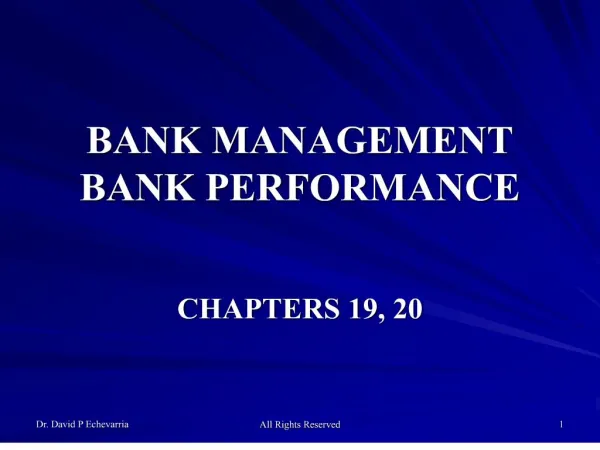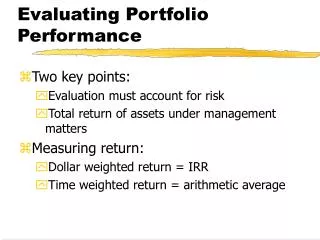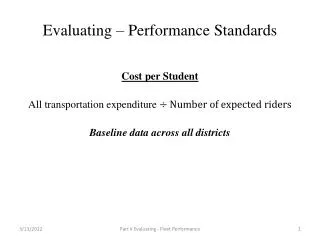Evaluating Bank Performance
Evaluating Bank Performance. Outline A Framework for Evaluating Bank Performance Internal Performance External Performance Presentation of Bank Financial Statements Analyzing Bank Performance with Financial Ratios Profit Ratios Risk Ratios
Share Presentation
Embed Code
Link
Download Presentation
- internal performance evaluations
- interest income
- where adjusted
- loan loss
- net interest margin
- all common

abram + Follow
Download Presentation
Evaluating Bank Performance
An Image/Link below is provided (as is) to download presentation Download Policy: Content on the Website is provided to you AS IS for your information and personal use and may not be sold / licensed / shared on other websites without getting consent from its author. Content is provided to you AS IS for your information and personal use only. Download presentation by click this link. While downloading, if for some reason you are not able to download a presentation, the publisher may have deleted the file from their server. During download, if you can't get a presentation, the file might be deleted by the publisher.
Presentation Transcript
- Evaluating Bank Performance • Outline • A Framework for Evaluating Bank Performance • Internal Performance • External Performance • Presentation of Bank Financial Statements • Analyzing Bank Performance with Financial Ratios • Profit Ratios • Risk Ratios • Internal Performance Evaluations Based on Economic Profit • RAROC (Risk-Adjusted Return on Capital) • EVA (Economic Value Added)
- A Framework for Evaluating Bank Performance • Internal Performance • Bank planning (policy formulation) • Goals, budgets, strategic planning • Technology • Computers, communications, payments • Personnel development • Challenges (personal selling and geographic expansion) • Job satisfaction (training and compensation)
- A Framework for Evaluating Bank Performance • External Performance • Market share • Earnings effects • Role of technology • Regulatory compliance • Capital • Lending • Securities • Other • Public confidence • Deposit insurance • Public image
- A Framework for Evaluating Bank Performance • Presentation of Bank Financial Statements • Balance sheet (Report of Condition) Assets: cash assets, loans, and securities Liabilities: deposit funds and nondeposit funds Capital: equity capital, subordinated notes and debentures, loan loss reserves • Income Statement (Report of Income) Interest income Noninterest income Interest expenses Noninterest expenses (including provision for loan losses) Net profit
- A Framework for Evaluating Bank Performance Table 3.1 Balance Sheet for State Bank ($Thousands) ASSETSDEC. 31, 2000 DEC. 31, 1999 Cash assets $ 9,039 $ 10,522 Interest bearing bank balances 0 1,000 Federal funds sold 10,500 1,500 U.S. Treasury and agency securities 54,082 44,848 Municipal securities 32,789 34,616 All other securities 0 0 Net loans and leases 90,101 81,857 Real estate loans 50,393 38.975 Commercial loans 9,615 11,381 Individual loans 8,824 10,640 Agricultural loans 20,680 19,654 Other loans and leases-domestic 3,684 4,025 Gross loans and leases 93,196 84,675 Less: unearned income reserves 89 282 Reserve for loan and lease losses 3,006 2,356 Premises, fixed assets, and capitalized leases 2,229 2,398 Other real estate 2,282 3,012 Other assets 4,951 4,014 Total assets $205,973 $183,767
- A Framework for Evaluating Bank Performance Table 3.1 Balance Sheet for State Bank ($Thousands) LIABILITIES & CAPITAL DEC. 31, 2000 DEC. 31, 2001 Demand deposits $ 23,063 $ 22,528 All NOW and ATS accounts 6,021 5,322 MMDA accounts 41,402 49,797 Other savings deposits 3,097 2,992 Time deposits$100K 83,009 57,665 Total deposits 188,299 167,258 Fed funds purchase and resale 0 0 Other borrowings 0 0 Bankers’ acceptance and other liabilities 3,546 3,101 Total liabilities 191,845 170,359 Subordinated notes and debentures 0 0 All common and preferred equity 14,128 13,408 Total liabilities and capital $205,973 $183,767
- Analyzing Bank Performance with Financial Ratios • Profit ratios • Rate of return on equity • ROE = NI/TE (net income after taxes/total equity) • Rate of return on assets • ROA = NI/TA (net income after taxes/total assets) • Other profit measures • Net interest margin • NIM = (Total interest income - Total interest expense)/Total assets • Note: municipal bond interest is not taxable, such that it must be grossed up to a pre-tax equivalent basis by dividing munis interest earned by the factor (1 - tax rate of bank).
- Analyzing Bank Performance with Financial Ratios • Profit ratios • Unraveling profit ratios • ROE = ROA x TA/TE (total assets/total equity or equity multiplier). • Thus, by decreasing equity, a bank can increase ROE based on any given level of ROA. ROE = NI/OR x OR/TA x TA/TE (where OR is operating revenue). The NI/OR ratio is the profit margin, while OR/TA reflects asset utilization. By using this breakdown, one can make inferences concerning the reason for say increases in ROE. If asset utilization and equity multiplier did not change, the profit margin must have increased due to cost savings pushing this ratio up.
- Analyzing Bank Performance with Financial Ratios • Risk ratios • Capitalization Leverage ratio Total equity/Total assets Total capital ratio (Total equity + Long-term debt + Reserve for loan losses)/Total assets Note: book values and market values likely are different and yield different results.
- Analyzing Bank Performance with Financial Ratios • Risk ratios Asset quality • Provision for loan loss ratio • = PLL/TL (provision for loan losses/total loans and leases) Loan ratio = Net loans/Total assets Loss ratio = Net charge-offs on loans (gross charge-offs minus recoveries)/Total loans and leases Reserve ratio = Reserve for loan losses (reserve for loan losses last year minus gross charge-offs plus PLL and recoveries)/Total loans and leases Nonperforming ratio = Nonperforming assets (nonaccrual loans and restructured loans)/Total loans and leases
- Analyzing Bank Performance with Financial Ratios • Risk ratios • Operating efficiency (cost control) Wages and salaries/Total expenses Fixed occupancy expenses/Total expenses • Liquidity Temporary investments ratio = (Fed funds sold, short-term securities, cash, trading account securities)/Total assets Volatile liability dependency ratio = (Total volatile liabilities - Temporary investments)/Net loans and leases Note: This ratio gives an indication of the extent to which “hot” money is being used to fund the riskiest assets of the bank.
- Analyzing Bank Performance with Financial Ratios • Other financial ratios • Tax rate = Total taxes paid/Net income before taxes • Dollar gap ratio = Interest rate sensitive assets - Interest-rate sensitive liabilities Total assets where rate-sensitive means short-term with maturities of less than one year (or repriced in less than one year).
- Internal Performance Evaluations Based on Economic Profit • RAROC (Risk-adjusted return on capital) • Example Cost of funds 5.00% Provision for loan losses 1.00 Direct expense 0.50 Indirect expense 0.25 Overhead 0.25 Total charges before capital charge 7.00% Capital charge* 2.29 Total required loan rate 9.29% *Note: The capital charge is determined by multiplying the equity capital allocated to the loan times the opportunity cost of equity and then converting to a pre-tax level. Assume that the allocated equity to loan ratio is 10% and the opportunity cost of equity is 16%, such that the after-tax capital charge is 1.6%. If the tax rate for the bank is 0.3, the pre-tax capital charge is 1.6/(1.0-0.3), or 2.29. In this example, if the loan rate is 9.29%, the bank will earn the target return on equity of 16%. Of course, if the bank can price the loan at a rate higher than 9.29%, it will earn profit over the target level of equity returns. In this case an economic profit is earned in that the value of equity is increased.
- Internal Performance Evaluations Based on Economic Profit • EVA (Economic value added) = Adjusted earnings – Opportunity cost of capital, where adjusted earnings is net income after taxes, and the opportunity cost of capital equals the cost of equity times equity capital. • RAROC and EVA • Both methods are beneficial in assessing managerial performance and developing incentive compensation schemes compatible with shareholder wealth goals. • RAROC has a short-run perspective (i.e., business unit profit is compared to the unit’s capital at risk) • EVA has a long-run perspective (i.e., business unit profit is compared to the cost of capital of the bank)

Evaluating Performance
Evaluating Performance. COSC 201. Administrivia. I’ve graded through lab 4 will email your grades when I finish lab 5 homework due tomorrow I’ll post the HW answers once they’re turned in Lab on Tuesday: Datapath ALU and other Logisim examples from class are on the webpage
662 views • 25 slides

BANK MANAGEMENT BANK PERFORMANCE
Dr. David P Echevarria. All Rights Reserved. 2. BANK PERFORMANCE EVALUATION . Bank ProfitsP = Loans x Realized Loan Yield minus Deposits x Cost per $ of Deposits - Fixed ExpensesRLY = Contractual rate x Good Loan Fraction - (1-Recov. rate) x Bad Loan FractionCost of Deposits = Interest paid plus the cost of free servicesFixed Costs = the cost of everything else the bank needs to run the business.
573 views • 18 slides

Evaluating Financial Performance
Evaluating Financial Performance. Finance Jaime F. Zender. Note: Because I have found no better presentation of this material, this closely follows the presentation in the Higgins book. Financial Performance.
846 views • 33 slides

EVALUATING FINANCIAL PERFORMANCE
EVALUATING FINANCIAL PERFORMANCE. Objective : To enable participants to evaluate and report on financial performance for governmental entities. 1. ANALYZING GOVERNMENT FINANCIAL PERFORMANCE. Why do we care? Governments can become bankrupt.
1.75k views • 142 slides

Evaluating Portfolio Performance
Evaluating Portfolio Performance. Two key points: Evaluation must account for risk Total return of assets under management matters Measuring return: Dollar weighted return = IRR Time weighted return = arithmetic average. Risk adjusted performance measures: The Big 3. Sharpe measure (S):
303 views • 4 slides

BANK MANAGEMENT BANK PERFORMANCE
BANK MANAGEMENT BANK PERFORMANCE. CHAPTERS 19, 20. BANK PERFORMANCE EVALUATION . Bank Profits P = Loans x R ealized L oan Y ield minus Deposits x Cost per $ of Deposits - Fixed Expenses RLY = Contractual rate x Good Loan Fraction - (1-Recov. rate) x Bad Loan Fraction
441 views • 18 slides

Evaluating – Fleet Performance
Evaluating – Fleet Performance. SE-4094 Transportation Expense Report Interactive Form And Data Analytics.
227 views • 9 slides

Evaluating Computer Performance
Evaluating Computer Performance. Edward L. Bosworth, Ph.D. Computer Science Department Columbus State University. The IBM Stretch. The IBM 7030, called the “Stretch” was intended to be 100 times as fast as existing IBM models, such as the 704 and 705.
786 views • 27 slides

Evaluating – Performance Standards
Evaluating – Performance Standards. Cost per Student All transportation expenditure Baseline data across all districts. Evaluating – Performance Standards. Daily bus as % of total fleet Full service buses ÷ Total fleet buses Spare bus factor Age of fleet Changes in eligibility.
343 views • 20 slides

Evaluating Employee Performance
Evaluating Employee Performance. Chapter 8 Meredith Johnson And Chris Chandler. Purposes of Performance Evaluation. Purpose of Performance Evaluation. Summative Evaluations are done annually or semiannually.
465 views • 16 slides

Evaluating Portfolio Performance
Evaluating Portfolio Performance. Ch.20b. Universe Comparison. Divide performance of all active managers in the same category (e.g., Canadian equity) into quartiles. . Performance Attribution Analysis. For managers that are benchmarked
301 views • 12 slides

Measuring and Evaluating Bank Performance
Measuring and Evaluating Bank Performance. The purpose of this seminar is to discover what analytical tools can be applied to a bank’s financial statements so that management and the public can identify the most critical problems inside each bank and develop ways to deal with those problems.
1.8k views • 12 slides

Measuring and Evaluating Bank Performance
Measuring and Evaluating Bank Performance. 6 July 2009 Ms. Kashmirr C. Ibanez. What is performance?. How adequately a financial firm meets the needs of its stockholders, employees, depositors and other creditors and borrowing customers
477 views • 25 slides

Ch. 6 Measuring and Evaluating Bank Performance
Ch. 6 Measuring and Evaluating Bank Performance. Based on Rose and Hudgins, Bank Mgt & Fin Services , Gup text, and adapted by Dorla Evans. Key Topics. Stock values Profitability ratios Measuring credit, liquidity, and other risks Size and location effects UBPR and comparing performance.
803 views • 47 slides

Evaluating Portfolio Performance
Evaluating Portfolio Performance. Introduction. Active vs. passive portfolio management Active selection will mean some non-systematic risk not holding a completely diversified portfolio Portfolio performance tied to manager’s compensation (directly or indirectly)
344 views • 14 slides

BANK MANAGEMENT BANK PERFORMANCE
BANK MANAGEMENT BANK PERFORMANCE. CHAPTERS 19, 20. BANK PERFORMANCE EVALUATION. Bank Profits P = Loans x R ealized L oan Y ield - Deposits x Cost per $ of Deposits - Fixed Expenses RLY = Contractual rate x Good Loan Fraction - (1-Recov. rate) x Bad Loan Fraction
432 views • 18 slides

EVALUATING EMPLOYEE PERFORMANCE
EVALUATING EMPLOYEE PERFORMANCE. Evaluating Employee Performance. Introduction Performance Management System Performance Appraisals And EEO The Appraisal Process Appraisal Methods Factors That Can Distort Appraisals Creating More Effective Performance Management Systems
412 views • 16 slides

Evaluating Channel Performance
Evaluating Channel Performance. Measurement of Channel Performance. Performance may be define as‘ the sum of all processes that will lead managers to taking appropriate actions in the present that will create a performing organisation in the future’
594 views • 25 slides

Evaluating Agency Performance
Download the PDF: https://www.demandmetric.com/content/evaluating-agency-performance Evaluating agencies can help you gauge the performance and alignment of key partners. To create an effective agency performance evaluation, evaluations must occur on a regular basis. There should be a neutral evaluator, a consistent format, 360-degree reviews, and a clear follow-up plan. This guide will explain why you need to evaluate your agency, what criteria you should use, and how to conduct an effective evaluation.
141 views • 10 slides

Evaluating Performance
Evaluating Performance. When we say one computer has better performance than another, what do we mean? If you run a program on 2 computers, you'd say the faster one is the one that gets the job finished first.
138 views • 10 slides






















